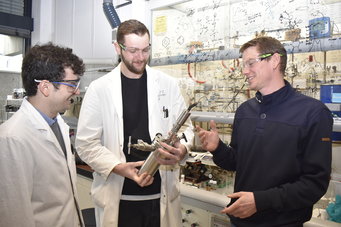Separate teams of Chinese and American scientists are reported to be developing body armour using the silk from genetically modified silkworms. The researchers modified the genes of silkworms to make them produce spider silk instead of their own silk.
Author
Lloyd Strickland
Professor of Philosophy and Intellectual History, Manchester Metropolitan University
Harnessing the properties of spider silk has been a longstanding aim because the material is as strong as steel, yet also highly elastic. However, the idea of using silk to make bulletproof vests is not a new idea. Instead, it goes back centuries.
The invention of the silk bulletproof vest is often credited to the American physician George Emory Goodfellow (1855-1910), following his observation that silk was impenetrable to bullets.
But the idea was in fact proposed more than two centuries earlier by the German polymath Gottfried Wilhelm Leibniz (1646-1716), best known as inventor of calculus and binary arithmetic. Let’s begin with the known history.
As a medical practitioner in the American frontier town of Tombstone, Arizona, during the late 1800s, Dr Goodfellow saw his fair share of gunshot wounds. Some of the cases he observed revealed “the remarkable tenacity of silk fibre and its resistance to the penetrative power of a bullet”.
On April 3 1882, under the heading “Silk as Bullet Proof”, The Tombstone Epitaph reported Dr Goodfellow’s surprise at finding two buckshot pellets embedded in the folds of the silk handkerchief of shotgun victim Billy Grounds. However, other pellets had penetrated his hat, face, and skull.
The report concluded that “a silken (armour) may be the next invention”. Five years later, Dr Goodfellow published further observations in “Notes on the Impenetrability of Silk to Bullets” in a journal called The Southern California Practioneer.
In its pages, he recounted two further cases in which a gunshot victim’s silk handkerchief was found to be resistant to bullets, so much so that the bullet had driven the (largely undamaged) handkerchief into the victim’s body, making it look as though it had been purposely stuffed into the wound to stop the bleeding.
Using Goodfellow’s findings, the Catholic priest Casimir Zeglen (1869-1927) would later invent a silk bulletproof vest. But the potential for silk as ballistic body armour had been recognised more than two centuries earlier, by Leibniz.
Although best known in his own day – and even in the present-day – as a mathematician and philosopher, Leibniz was a universal genius who made innovative contributions to numerous disciplines. He wrote hundreds of manuscript pages on military matters, but published none of them. Most of these writings remain unpublished even today.
In one of these little-known writings, unassumingly entitled “Plan for a military
manufacturing process”, Leibniz sought to identify a material suitable for making a
lightweight, flexible, bulletproof fabric. He briefly considered metal wires, layered metal sheets, and layered “goldbeater’s skin”, which is a material made from ox intestine. However, he devoted most of his attention to silk.
Whereas Goodfellow had observed the impenetrability of silk by bullets, Leibniz
never had. Instead, he thought silk was the most promising material for a bulletproof fabric due to being lightweight, flexible, and strong. “Of all the materials we use for fabrics, and which can be obtained in quantity, there is nothing firmer than a silk thread,” he wrote.
Noting that silk was never firmer than in the cocoon, “where the silk is still gathered in the way that nature produced it”, Leibniz proposed making a fabric formed of silkworm cocoons tightly pressed together with a little glue.
He realised that while such a sheet could not easily be pierced, due to the tightly-woven silk in the cocoons, it would be prone to tearing where one
cocoon met the next. Thus, he inferred that a bullet would not make a hole in the fabric, but instead tear whatever cocoon it hit from the surrounding ones, and drive it into the body, similar to what Goodfellow would observe with the silk handkerchief two centuries later.
Leibniz’s solution to the tearing problem was to propose layering sheets of pressed silkworm cocoons on top of each other. He illustrated this with a rudimentary diagram of a row of circles stacked on top of one another in a lattice arrangement, where a small interstice is left between adjoining circles.
Layering cocoons in such a hexagonal packing arrangement ensures that the
weak parts of one layer are covered by the strong parts of another. This way, the fabric would not tear or be pierced when hit by a bullet. The result, Leibniz claimed, would be a fabric suitable for covering almost the whole body, especially if it was made to be oversized, affording the wearer freedom of movement.
Leibniz never realised his proposal to create bulletproof clothing using silk. He was no engineer and would not have been able to manufacture the fabric himself. What is more, he often struggled to find engineers capable of manufacturing his inventions. For example, he also designed a calculating machine which, despite his lifelong efforts to get it built, never materialised into a fully functioning prototype.
His idea for silk bulletproof clothing therefore did not get off the drawing board. His manuscript was quietly filed away with tens of thousands of others, destined to anticipate later discoveries rather than to influence them.
![]()
Lloyd Strickland does not work for, consult, own shares in or receive funding from any company or organisation that would benefit from this article, and has disclosed no relevant affiliations beyond their academic appointment.





